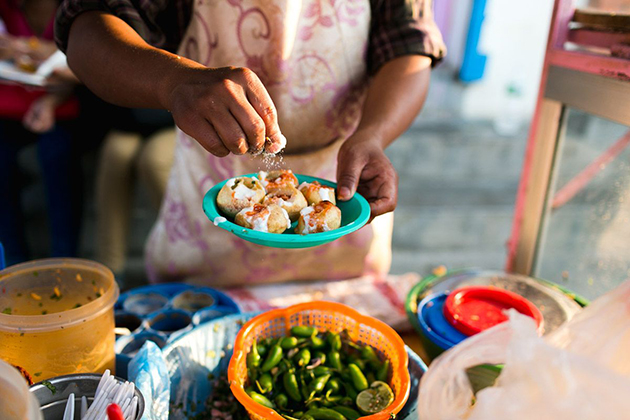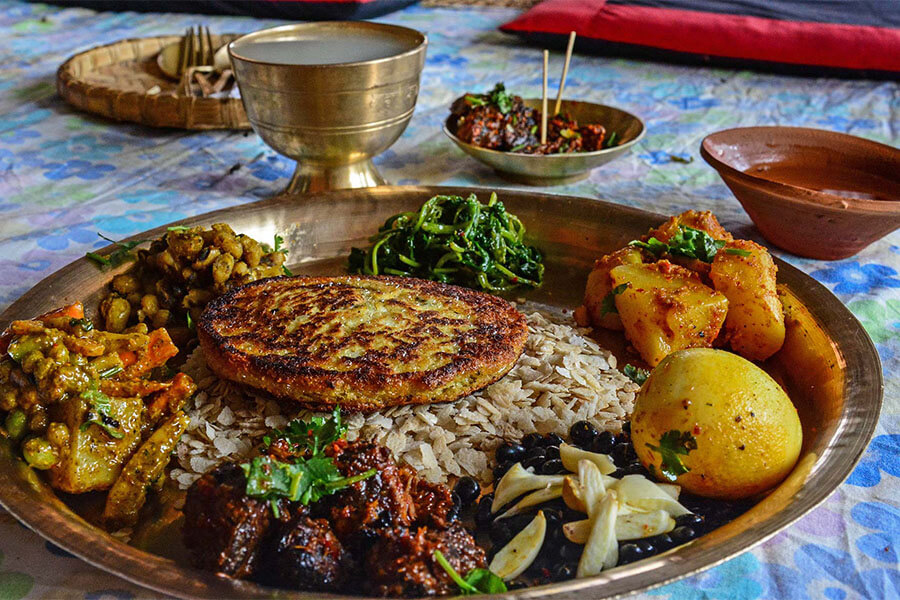Nepal … Its mountains, the organized brothel of Kathmandu, the inhabitants and the culinary specialties. When reading travel stories of this country, people seem tired of the cuisine of Nepal – a small country wedged between India and China, two countries with thousands of different flavors. Nepalese cuisine is not yet well known around the world as its neighboring. However, it is nonetheless interesting. It is based on vegetarian dishes made of rice and lentils. Here are some dishes to help you discover the true taste of Nepal.
1. Dal Bhat, The National Dish of Nepal
The national Nepal dish is Dal bhat, generally vegetarian (by religious conviction, but especially by necessity, meat is often inaccessible in many families), the dal baht is composed of rice (baht), a thick soup with lentils (dal), a curry of vegetables (tarkari) and is often accompanied by spicy vegetables macerated in vinegar (achaar). Sometimes, a little yoghurt is served on the plate-plate (thali) which makes it possible to calm the “fire of the mouth” of the delicate palates. In Nepalese restaurants, Dal bhat is served at will.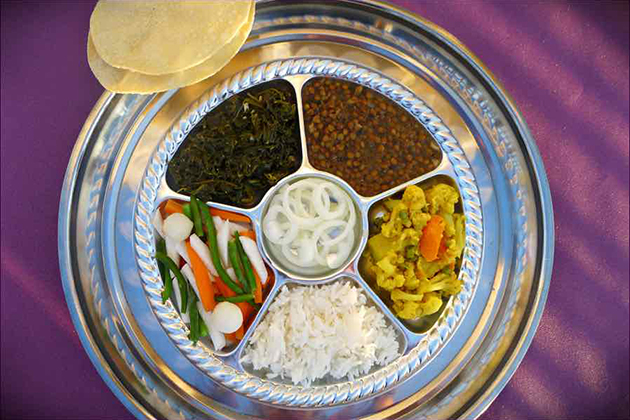
2. The Paratha Cake for Breakfast
Paratha cake made from flour is eaten with sugar or jam in the morning for breakfast. This is not the only breakfast of the Nepalese. Nepalese cuisine is heavily influenced by Tibet. So, cereals (barley or buckwheat) are usually eaten in form of noodles or flour to make breads.
3. The Momos are The Reference in The Himalayas
Even though the momos are from Tibet, they are served at every street corner in Kathmandu and in all the mountain lodges. Momos are small steamed ravioli with vegetables or meat. These are small bites that are consumed at any time in the Himalayan region and even beyond the Nepalese borders. In Tibetan, momo means “8”, which is why they are usually served by 8. They are also usually accompanied by a hot sauce. The momo can be served simply steamed, or kothey (as above), that is, steamed before being browned on one side of the pan or fried. You can order them anytime, but they mostly serve as a dessert to eat with ice.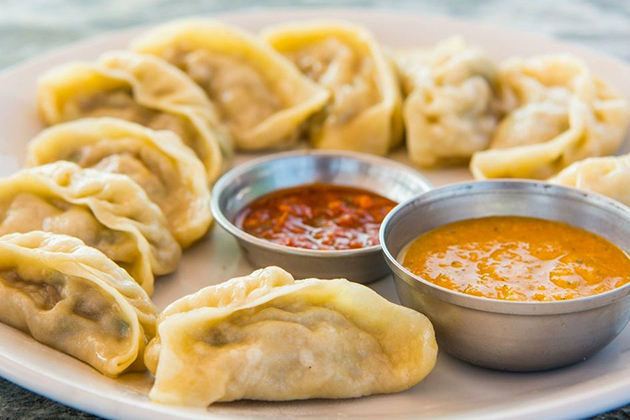
4. The Cuisine of The Newars
One of the best cuisines in Nepal is definitely the traditional Newar cuisine. It is found mainly in the Kathmandu valley, it is as rich as spicy. You will be surprised to see that in the Newar cuisines, people serve the beaten and fried rice, a good way to soften the too spicy flavors. You will be impressed at a traditional Newar meal by the multitude of dishes. About a dozen dishes, small potatoes returned to cumin and turmeric, small rakes of bamboo shoots, grilled chicken, smoked or marinated, small cakes fried with delicious eggs … There are often meat in Newar dishes, buffalo, chicken or mutton. Often Tibetan specialties like momos are served as starters.
5. The Tibetan cuisine
In the arid world of the northern Himalayas, Indian spices have never penetrated and rice has long remained an exotic plant, native to tropical and distant lands. The development of the local cuisine has obeyed the need to fight against the cold and to find food in a region where agriculture is difficult and where winter temperatures plunge well below zero: Tibetan food meets the same constraints as those of all cold countries. Tibetan dishes can be found in mountainous cuisine such as Mustang, Khumbu and Dolpo. Trans-Himalayan traders have also shared their taste for soups and noodles in Newar, and more recently, Tibetan refugees have introduced their strong mountain diet into the Hill Region and Terai.
The authentic Tibetan diet is based on tsampa (crushed barley), sometimes with a strong fragrant tea yak butter – salty and not sweet. Tibetans have also borrowed the art of making noodles from the Chinese, but with a more rustic twist. Apart from the ubiquitous momo, Tibetan thupka has conquered Nepal. This variation on noodle soup usually includes chopped vegetables and noodles, chicken or buffalo meat. Particularly stimulating, thenthuk, thicker than thupka, is embellished with large squares of pasta.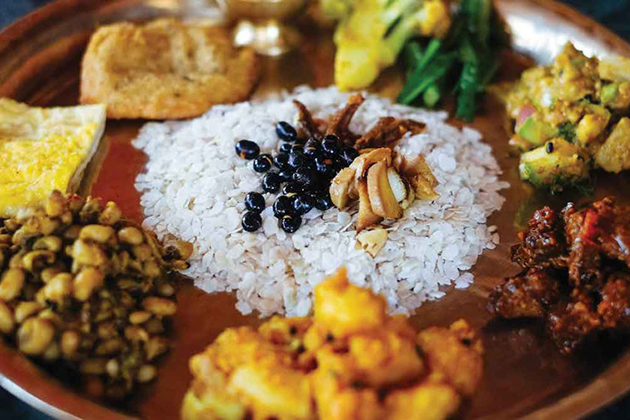
6. The Dhido
Dhido, what is it? The name of this Nepal dish may seem exotic when in reality it is only a simple paste or porridge made from flour. A typical rural dish, dhido can be prepared with different flours depending on what is grown in the region such as corn flour, millet, wheat or buckwheat are used. The dhido replaces the dal bhat (national dish) in some areas where it is difficult to grow rice, mainly on the tables of families who can not afford to buy rice.
Served on the Nepalese platter, the dhido is usually eaten with a spicy broth in which vegetables float, achaar (vinegar vegetables) and spicy sauce or, like the dal bhat, with a dal (soup of lentil), a tarkari (vegetable curry) and achaar.
When enjoy this dish, forget your spoon and fork, wash your hands, put your left hand on your lap (it should not touch the food, it is used to wipe the buttocks in the bathroom), form a 2-3 cm dumpling diameter in your hand, dip it in the spicy sauce then in your vegetable broth or in your dal. Pick a few achaar and/or vegetables to enjoy. Theoretically, you are not supposed to chew dhido too long … But, to facilitate digestion, we advise you to chew the whole … otherwise, beware of indigestion!
7. The Street Food of Nepal
Traditionally, the Nepalese make two meals a day: Dal Bhat at 10 am and dal bhat around 17-18h. So, during the day, when they are hungry, they nibble snacks much healthier than what we find in our vending machines. The most popular snack is puffed rice with boiled potatoes, green peppers, red onion, spices, coriander and lime.